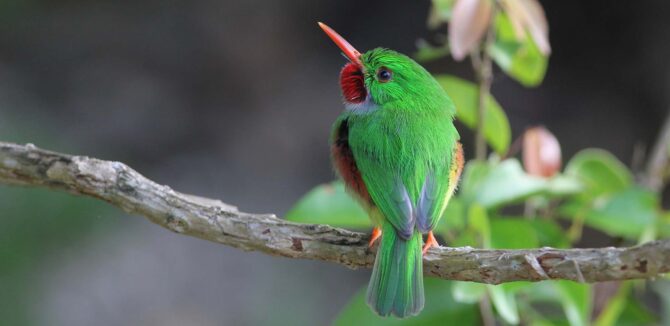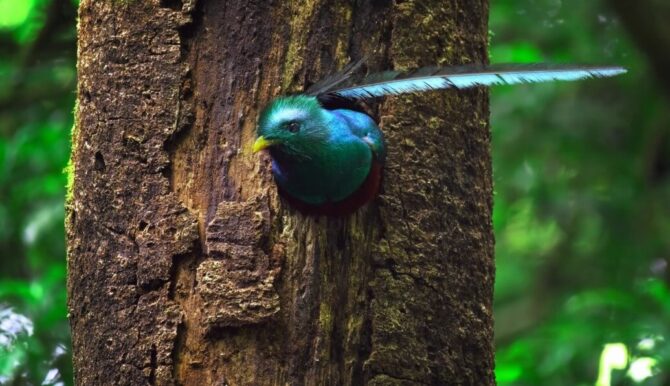Birds are often associated with beauty, color, and glamour, but sometimes this blinds us to the fact that not every species make the beauty cut.
Many avian species out there look unattractive to the human eye, and these would be classified as ugly birds.
This article will take us away from the glitz and glamour of the most beautiful birds to the other side of the avian beauty spectrum.
The ugliest birds in the world include the cinereous vulture, eastern wild turkey, Andean condor, and Muscovy duck, among others.
Discover these weird-looking birds that don’t make the beauty cut and some interesting facts you need to know.
The Ugliest Birds in the World
1. Muscovy Duck
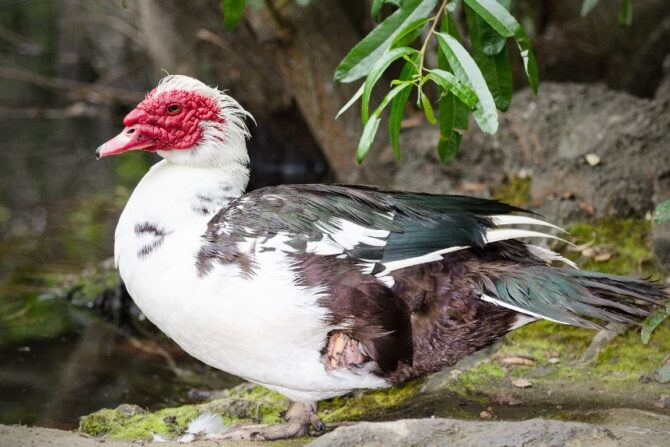
- Scientific Name: Cairina Moschata
- Where Found: The Americas
The Muscovy duck lives in different parts of North, Central, and South America. Countries where you can find this bird include Texas, Mexico, Uruguay, and Argentina.
There are some individuals beyond its range, found in places like New Zealand, Australia, and Europe. The Muscovy duck is large, weighing up to 15 pounds.
Ducks and geese are usually fine, but the Muscovy duck didn’t seem to get the memo.
Its unattractiveness is due to the red caruncles and black patches on the face. The black and pink bill also contributes to its unappealing looks.
Other parts of its body are better, though the male is more colorful than the female.
The Muscovy duck was domesticated by Colombian and Peruvian Indians.1
2. Andean Condor
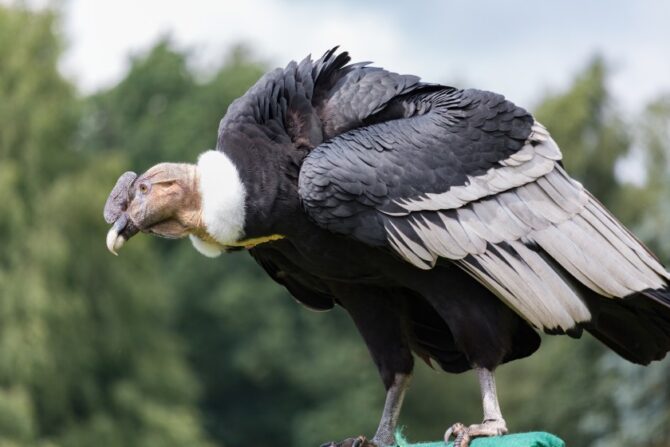
- Scientific Name: Vultur gryphus
- Where Found: South America
The Andean condor is a native of South America and the only species in the Vultur genus.
It specifically stays in the Andes mountains and Pacific coasts. Using weight and wingspan as criteria, the Andean condor is the largest flying bird in the world.
However, its looks leave nothing to be desired. The Andean condor has black plumage with white feathers at the neck and white patches on the wings of the male.
Overall, its looks provide a good reason vultures symbolize death.2
Like other vultures, the Andean condor is a scavenger.
3. Eastern Wild Turkey
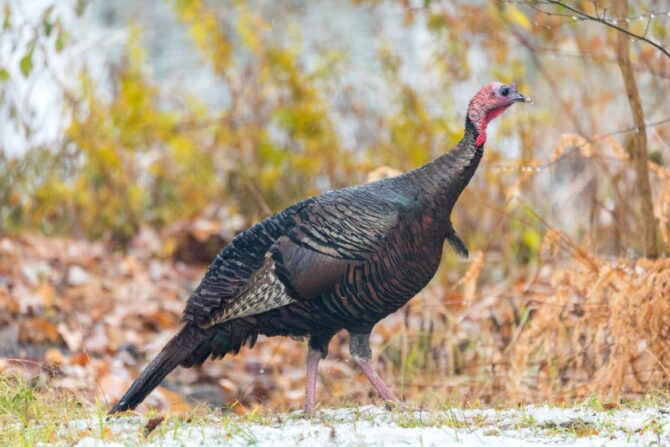
- Scientific Name: Meleagris gallopavo
- Where Found: North America
The eastern wild turkey is one out of two existing turkey species in the world, the other being the ocellated turkey.
It is also from wild turkeys that we have the domesticated kind. The eastern wild turkey is the heaviest member of the Galliformes order and comprises chickens and pheasants.
Though the wild turkey is an ancestor of the domesticated variant, it looks wilder. Its feathers are gray or black, and the head is red, making it look eerie.
The wild turkey also has caruncles like the Muscovy duck. Males are visibly larger than females, and they are more colorful.
4. Cinereous Vulture
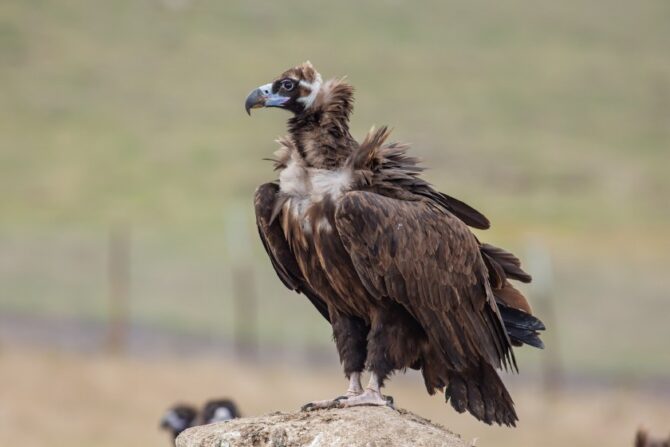
- Scientific Name: Aegypius Monachus
- Where Found: Europe, Asia
The cinereous vulture belongs to the Accipitridae family and prefers being in temperate environments.
It is distributed across the Eurasian region, which earned it the alternative name Eurasian black vulture.
Other names include the black vulture and the monk vulture. This bird is the largest old-world vulture, as well as the largest in its family.
The cinereous vulture has a gray head and dark brown feathers, making it look electrocuted.
Unlike other vultures, this bird can eat live animals. However, it feeds on carrion too.
5. Marabou Stork
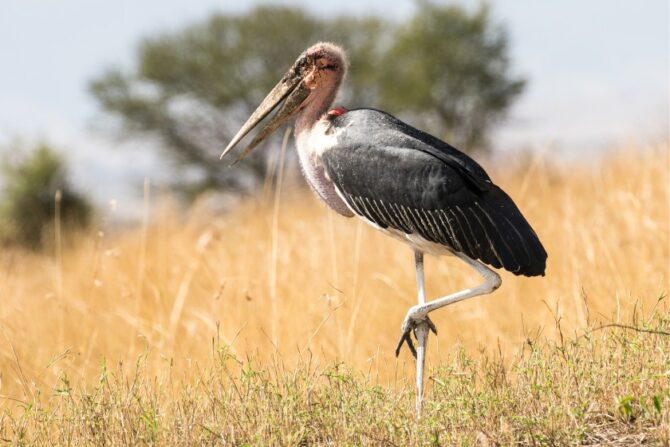
- Scientific Name: Leptoptilos crumenifer
- Where Found: Africa
The Marabou stork is a native of Sub-saharan Africa and belongs to the Ciconiidae family.
It inhabits both wet and arid habitats, staying close to human dwellings. It is a huge bird, reaching a weight of 20 pounds. There’s no way anyone can miss this bird!
The Marabou stork is nicknamed “undertaker bird,” which should explain why it is on this list.
It has black wings and plumage with skinny legs and white hair. From behind, this stork does look like an undertaker.
Its red face and long beak don’t help improve its looks. To complete the undertaker flair, the Marabou stork has an ill temper.
6. Sri Lanka Frogmouth
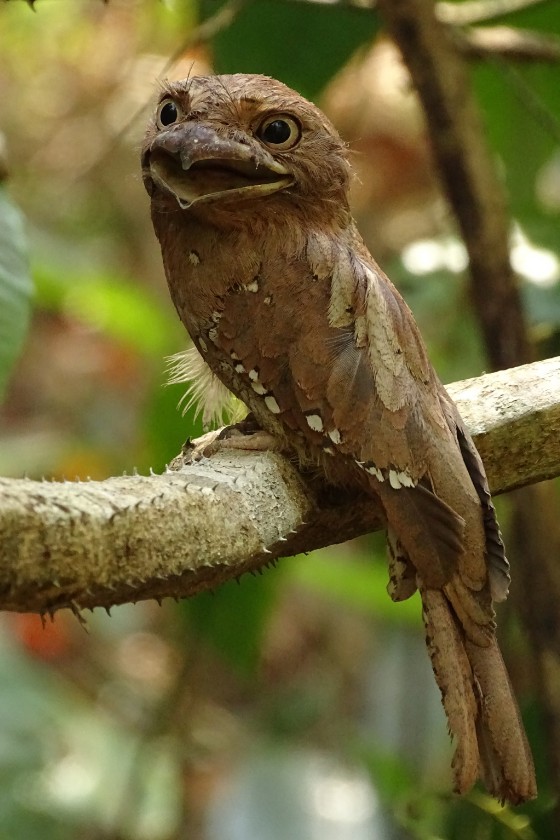
- Scientific Name: Batrachostomus moniliger
- Where Found: India, Sri Lanka
The Sri Lanka frogmouth is part of a group of nocturnal birds known as the frogmouth.
The latter is related to some other birds like owlet-nightjars and hummingbirds. As the name shows, it lives in Sri Lanka.
It can also be found in India, and it inhabits forests more in both places.
Many consider this bird ugly, but that is when you get to see it. The Sri Lanka frogmouth is good at camouflaging because its brownish color is like that of dried leaves.
It is not very vocal either, so you may miss it roosting in between leaves during the day. Overall, it is an unusual-looking avian.
7. Vulturine Guineafowl
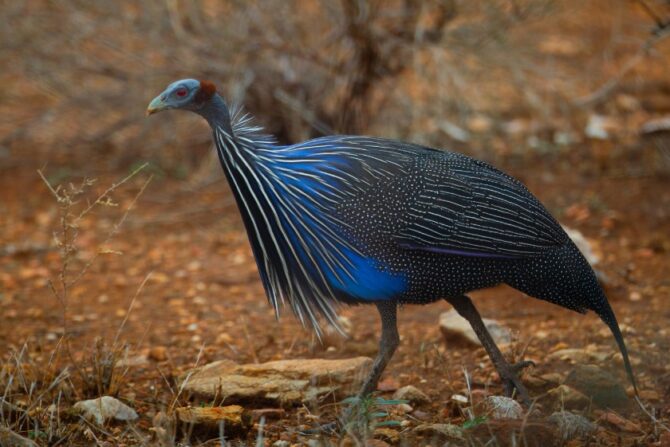
- Scientific Name: Acryllium vulturinum
- Where Found: Africa
The vulturine guineafowl falls under the Numididae family alongside other guineafowls. All of these birds can be found only in Africa.
The vulturine guineafowl, particularly, is located in Central Africa and the Northeast. Examples of countries you’d find this bird include Kenya, Tanzania, and Ethiopia.
The vulturine guineafowl is elegant in its poise, but it ticks every qualification of ugliness on closer inspection.
It has red eyes, a blue face that’s bereft of hair, and hackles colored blue with white. This bird looks a lot like a vulture, which explains the name.
8. Greater Adjutant
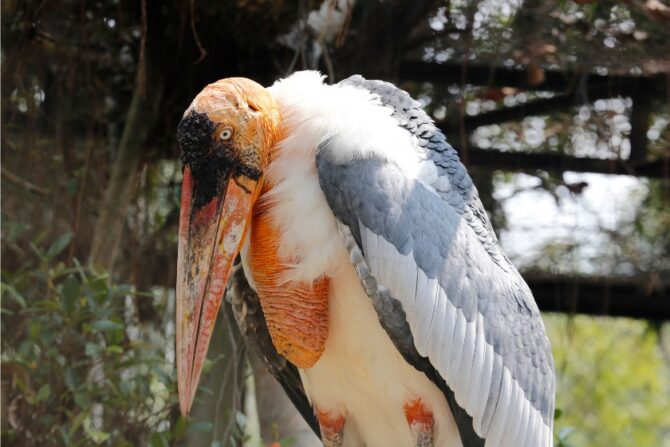
- Scientific Name: Leptoptilos dubius
- Where Found: Asia
The greater adjutant is a member of the stork family and going by genus; it is a relative of the Marabou stork.
Its range was once widespread across Asia, but due to population decline, it is restricted to India, Bhagalpur, and Cambodia. It is classified as endangered by the IUCN.
The greater adjutant is often associated with vultures, but it has its unique looks. The greater adjutant is unmistakable, with long legs, dark wings, and a long beak.
Even more noticeable is its size. The greater adjutant is one of the biggest storks. Altogether, this bird is not hard to miss, especially with its strange looks.
9. Saddle-billed Stork
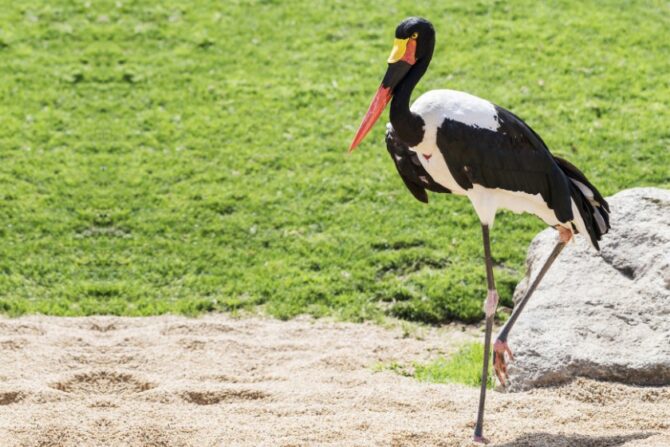
- Scientific Name: Ephippiorhynchus senegalensis
- Where Found: Africa
The saddled billed stork is a relative of the greater adjutant and Marabou stork as they all belong to the same family.
It is widespread across Sub-saharan Africa, specifically in countries like Sudan, Senegal, Côte d’Ivoire, South Africa, and Chad.
While this bird is classified as the least concern in other places it occurs, it is endangered in South Africa.
The saddled-billed stork is huge, much like other storks. Its plumage is black-and-white and iridescent.
This would have been enough to label this bird as beautiful but for its face. The long, downward beak gives the face a perpetual frown when perched, and the red eyes contribute to the ugliness.
However, the beak is colorful, a mixture of red, black, and yellow.
10. Wood Stork

- Scientific Name: Mycteria americana
- Where Found: Americas
And the storks keep on coming! The wood stork is under the family Ciconidae, and it is a native of North, Central, and South America.
The wood stork was once called a wood Ibis, though it no longer goes by this name. It inhabits subtropical and tropical habitats. It builds nests on trees like the mangrove.
The wood stork’s head and face look bruised. It is bare and dark grey, contrasting the white plumage.
The bill, legs, and tail are all black. The wood stork’s legs are thin and long, which helps it navigate its environment.
Males and females are similar, but juveniles have feathered heads and yellow bills.
Though the population is secure in other parts of its range, the wood stork faces challenges in the United States.3
11. Southern Ground Hornbill
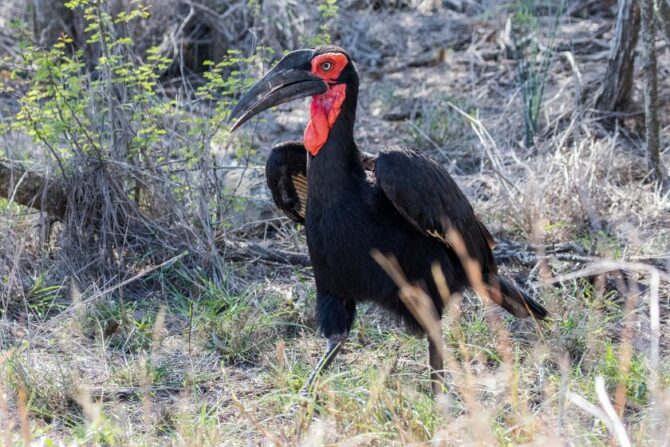
- Scientific Name: Bucorvus leadbeateri
- Where Found: Africa
The southern ground hornbill is a ground hornbill species, and only two species exist today.
Besides the southern ground, there is the Abyssinian ground hornbill.
Both are endemic to Africa, the southern ground living specifically in east and southern Africa. Preferred habitats include woodlands and savannas.
This bird is completely black except for the red patches on the throat and face.
These patches show bare skin, which can be strange to the casual onlooker but help keep dust out of the bird’s eyes.
12. Turkey Vulture
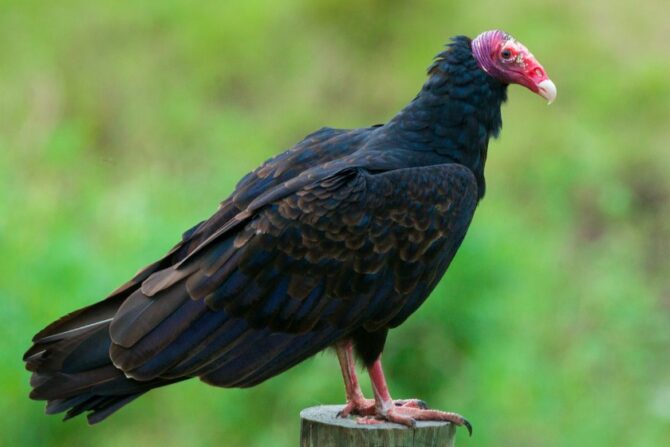
- Scientific Name: Cathartes aura
- Where Found: Americas
The turkey vulture is in the family Cathartidae and is considered the most widespread of New World Vultures.
Its range extends from Canada to the southernmost parts of South America. In some areas, it is named the buzzard, turkey buzzard, or carrion crow.
Like the Marabou stork, the turkey vulture looks like it wears a cloak. It has an all-black plumage except for the redhead.
The beak is also red, but the tip has a yellow color. The wingtips are also white. The head size is small when compared to the body.
13. California Condor
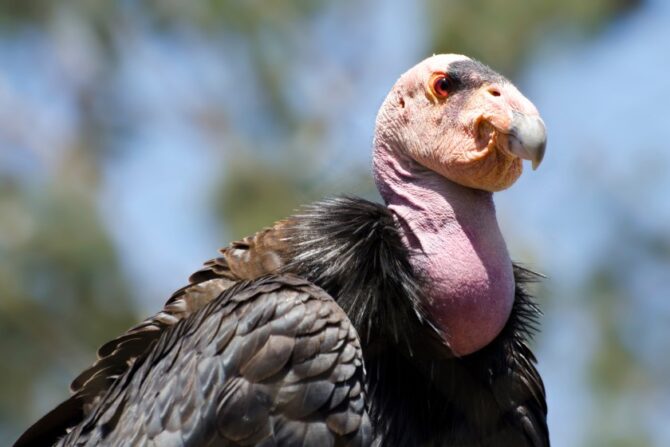
- Scientific Name: Gymnogyps californianus
- Where Found: North America
The California condor is in the Carthatidae family, and it is a native of North America. It is considered the largest land bird in its environment.
The California condor’s population has declined drastically and has become extinct in the wild.
Fortunately, its reintroduction in areas like northern Arizona and Utah keeps it alive. It is currently classified as critically endangered by the IUCN.
Besides the white patches underneath the wings, the California condor has black plumage.
The head is bare, which contributes to its ugliness but is helpful because it prevents dead carrion from sticking to the face.
This condor is somewhat quiet, capable only of a few hisses and grunts.
14. Silvery-cheeked Hornbill
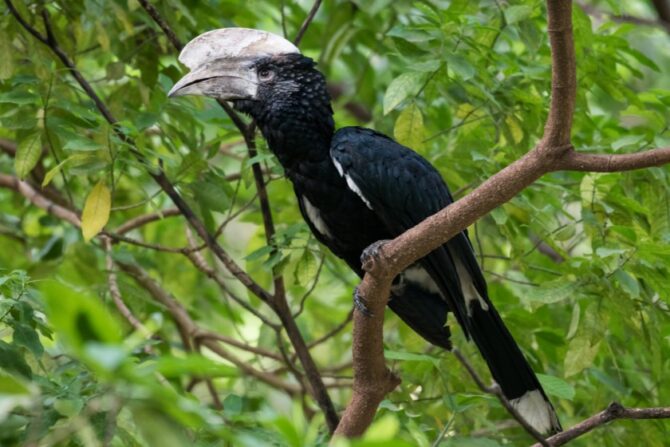
- Scientific Name: Bycanistes brevis
- Where Found: Africa
The silvery-cheeked hornbill is in the Bucerotidae family which all hornbills belong.
Hornbills are spread around Africa and Asia, but the silvery-cheeked hornbill is found only in Africa.
It can be found in Ethiopia, South Africa, and Zimbabwe. It is threatened in places like Zimbabwe, but overall it is classified as Least Concern.
The silvery-cheeked hornbill has a silvery grey, and its most noticeable feature is the creamy casque sitting on top of the brown, curved beak.
The casque makes its face looks strange, but that remains the bird’s uniqueness. This casque makes the bill stronger.
15. Jabiru
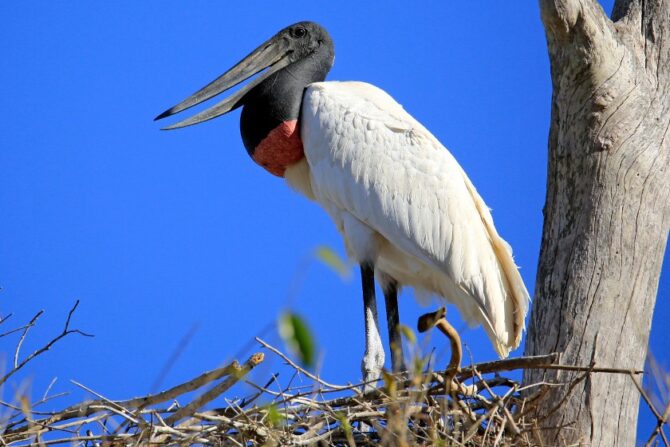
- Scientific Name: Jabiru mycteria
- Where Found: Americas
The jabiru is a stork, and it shares similar characteristics with many other storks, especially in terms of size.
It is a native of the Americas, and you can find it in countries like Mexico and Argentina. You can also encounter them in the United States.
The name “jabiru” means “swollen neck,” a nod to one of its most prominent traits.
It has white plumage, but its head and neck are black with no feathers. At the base is a red pouch. Its legs are long and thin like sticks.
16. Southern Bald Ibis
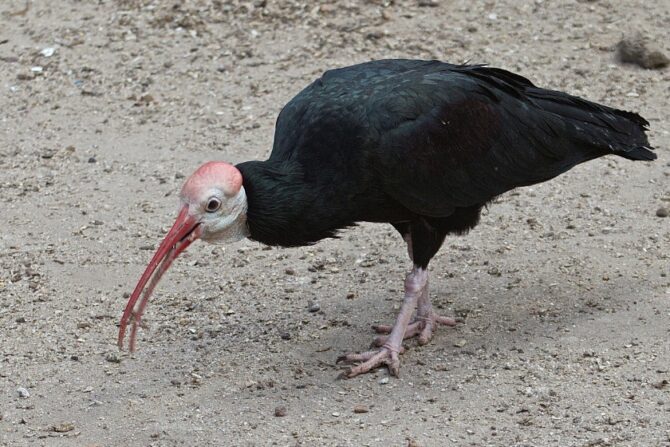
- Scientific Name: Geronticus calvus
- Where Found: Africa
The southern bald ibis is in the geronticus genus alongside the northern bald ibis, which we’ll be looking into next.
It is found in the southern parts of Africa, where it inhabits open grasslands and semi-deserts. It can also live in mountainous areas.
Just as the name shows, the bald ibis has a featherless head. Its face is bare white with red streaks.
The beak is long and red as well. Its baldness is the main factor that contributes to the ugliness, as the featherless head looks unusual.
17. Northern Bald Ibis
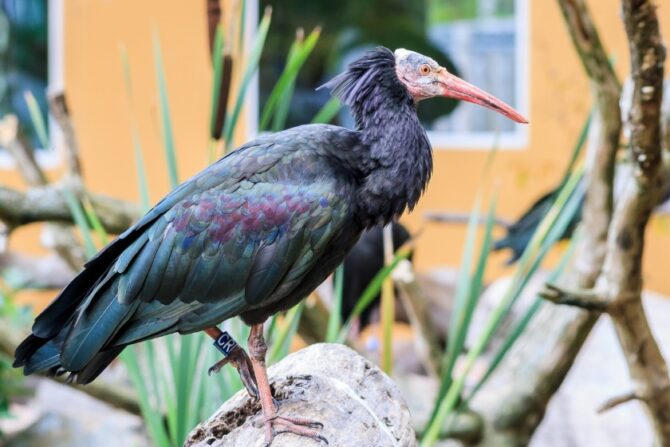
- Scientific Name: Geronticus eremita
- Where Found: Africa
The northern bald ibis is a close relative of the southern bald ibis. It also goes by other names like the hermit ibis or the waldrapp.
This bird distinguishes itself from other ibises by being non-wading.
The northern bald ibis once had a wider range from the Middle East to Africa to Europe. Sadly, it is now endangered and restricted to North Africa.
The northern bald ibis is uglier than its southern counterpart, mainly because of its bald red face and head.
The beak and legs are also red. The plumage is black but iridescent, arguably the finest feature of this bird.
18. Roseate Spoonbill

- Scientific Name: Platalea ajaja
- Where Found: North and South America
The roseate spoonbill is related to ibises and other spoonbills as they all belong to the Threskiornithidae family.
It is a native of both North and South America, where it dwells in countries like the United States, Mexico, and the Andes.
The roseate spoonbill does have one admirable physical trait: Its pink plumage that’s diet-derived.
This almost turned out to be a disadvantage as the bird was hunted for its plumes between the 17th and 18th centuries.
This almost led to its extinction, but fortunately, it bounced back, and it’s currently listed as Least Concern. Its bare greenish head and grey bill place it on this list.
19. King Vulture
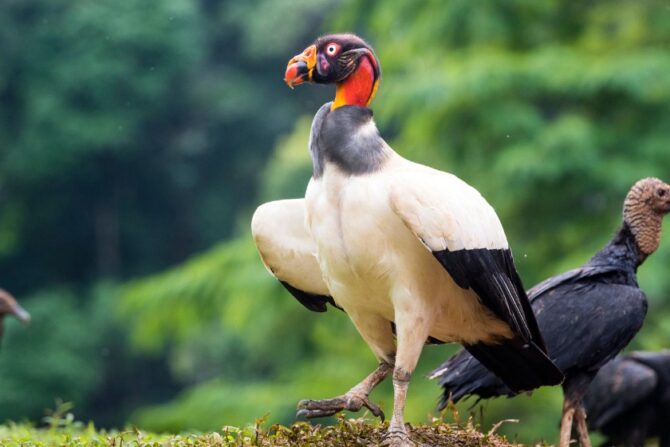
- Scientific Name: Sarcoramphus papa
- Where Found: Central and South America
The king vulture is a member of the carthartidae family, a large bird that deserves its name.
It lives in Central and South America, specifically in countries like Mexico and Argentina. Preferred habitats include tropical lowland rainforests.
Like many other birds on this list, the king vulture’s ugliness lies in the head.
While it comes with different colors that can be fun to observe, the head is bald, resulting in the “naked” look that appears strange.
Its plumage is a lot more attractive, coming in a black-and-white color.
20. Shoebill
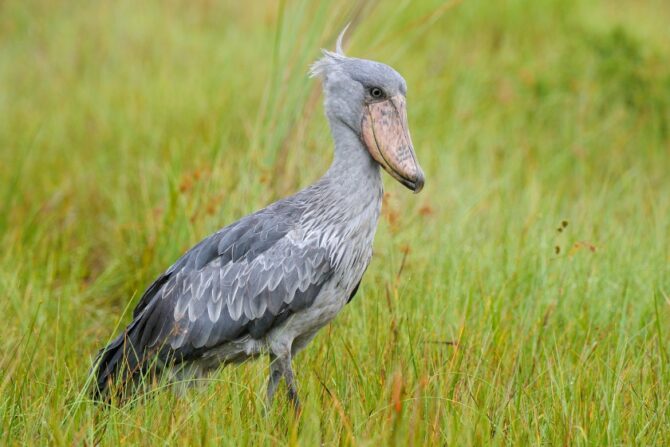
- Scientific Name: Balaeniceps rex
- Where Found: East Africa
The shoebill goes by many other alternative names like the whalebill, the whale-headed stork, and shoe billed stork.
It is a native of East Africa in countries like South Sudan and Kenya. This bird dwells in large swamps.
The shoebill looks like a creature out of the stone age due to its overall grey look.
This describes the adult, though, as juveniles are brown. Its most popular feature is the bill shaped like a shoe (hence the name).
FAQs
Why are some birds ugly?
Ugly birds tend to be classified as such because of the absence of feathers on some parts of the body, usually the head. This would make the head look naked and unappealing. Some ugly birds also have strange features, like very thin legs.
Final Thoughts
Ugly birds have a few qualities in common, one of which is that they tend to be bald.
However, this is advantageous for them as it helps them feed and survive.
Despite whatever aversion we have to their looks, even these ugliest birds in the world have roles to play, mainly in the decomposition of carrion.
Next up…
References & Notes
- Recommendation concerning Muscovy Ducks and hybrids of Muscovy and domestic Ducks. Council of Europe.
- Curtis F. 2015. 14 Symbols of Death From Our Collection. Bristol Museum & Art Gallery.
- Wood Stork: Species Profile. Everglades National Park (U.S. National Park Service)

